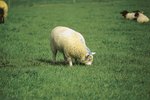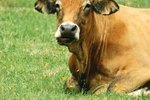Things You'll Need
Lamb feed or milk
Clean water
Clean bedding
Chlortetracycline
Colic in sheep refers to any general abdominal pain, but one of the most common sources of colic is enterotoxemia, or overeating disease. This condition is caused by a bacteria found in soil and manure. It kills many young lambs, and is characterized by indigestion and colic. Correct management can help you prevent and control enterotoxemia, improving the overall health of your flock.
Maintain steady feed or milk intake. Enterotoxemia is usually triggered by overeating, which enables clostridium perfringens bacteria to grow excessively. When transitioning lambs from roughage to a concentrated diet, do so gradually, over the course of two to three weeks. Avoid sudden changes in what you feed your sheep.
Vaccinate pregnant ewes. Have your veterinarian vaccinate your animals six to eight weeks before their first lambing, then again two to four weeks before lambing. In succeeding years, vaccinate once, two to three weeks before lambing. Rams may be vaccinated once per year.
Monitor lambs during stressful periods. In hot weather, their appetite may decline, causing them to overeat when the weather cools. Restrict feeding to appropriate levels to prevent colic. Maintain comfortable temperatures whenever possible.
Maintain appropriate water levels. Dehydration can cause sheep to eat significantly less. Their appetite will go up when water is provided again, increasing the risk of colic. Provide a steady source of clean water at all times to prevent this.
Keep bedding clean and dry. Wet bedding is conducive to outbreaks of enterotoxemia. It increases the stress level of the animals, causing variable feeding and bacterial growth. This is a particular concern for ewes with high milk production and single lambs. Replace sheep bedding whenever it appears wet.
Adjust feed and medication. When an outbreak can't be prevented, add chlortetracycline (also known as Aureomycin) to the feed and increase the roughage level for several days. The appropriate dose of chlortetracycline is two hundred grams per ton.
Warnings
Always get the advice of a veterinarian before administering medication.
References
Photo Credits
-
lamb image by david purday from Fotolia.com
Writer Bio
G.D. Palmer is a freelance writer and illustrator living in Milwaukee, Wis. She has been producing print and Web content for various organizations since 1998 and has been freelancing full-time since 2007. Palmer holds a Bachelor of Arts degree in writing and studio art from Beloit College in Beloit, Wis.





